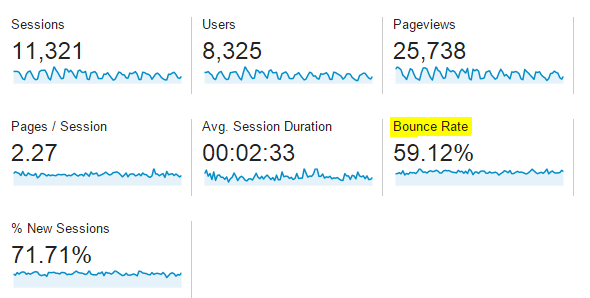To bounce or not to bounce?
This has been a dilemma faced by every person when visiting a website. But, some sites just make the decision so much easier. Yes, you know those sites that I am talking about—annoying pop-ups, audios on auto-play, super long forms to fill up, or those that take an eternity to load.
I don’t think you would regret leaving those sites immediately! Then again, there are those sites that make the decision more difficult, as they have good looking pages, have pleasing colors, grabs your attention, and provides the information you seek. You might consider staying on the site a little longer or paying it another visit.
Now, what if you were the owner of a site? Of course, you would really want your visitor to stay, look around, and hopefully complete your business objective. This is where the importance of Bounce Rate comes in.
What is Bounce Rate?
Bounce Rate is a single metric that tells you if your site’s visitors find it interesting or not. Depending on the kind of site you have, your bounce rate—either low or high might provide insights on what could be improved, as well as indicate bigger problems that your site might have.
The natural question would be, how is the bounce rate calculated? If you have Google Analytics (GA) installed on your website, bounce rate would be one of the default metrics shown on your dashboard.
As per Google: Bounce Rate is the percentage of single-page sessions (i.e. sessions in which the person left your site from the entrance page without interacting with the page).

Simply put, if a visitor lands on one of the pages of your site and immediately decides to leave, that is considered a bounce. Google Analytics provides a bounce rate for both the page and for the website.
Mathematically speaking,
Bounce rate of a page = (Visitors who only viewed a particular page/total numbers of entrances to that page)
Bounce rate of the website = (Total number of bounces across the website/total number of entrances across the website)
So, is a high bounce rate always bad? Not necessarily.
If your website is a directory where a visitor finds information on the entrance page, a high bounce rate could actually mean that the site is performing well. Hence, bounce rate needs to be considered in the context of the purpose and type of the site.
Causes of High Bounce Rates
-
Poor Landing Page Design
Is the page designed well? Is the content layout good? Are there huge pop-ups and audios/videos on auto-play?
If you’re running ads that land on the page, ensure that the page content and design are consistent with the ad and provide the relevant information as well. For example, when you key in the search term “Buy shoes online” and you see an ad that says “Huge collection of shoes! Buy Now!”
Upon clicking this ad, you are taken to a page that shows a selection of bags, watches, shoes, and shirts. How long would you stay on that page?
-
Absence of Poor Call to Action (CTA)
A clear, well-written CTA helps capture the attention of the visitor and encourages the visitor to take a particular action while on the site. Without a single, clear call-to-action, visitors are likely to deviate from fulfilling the goal of the page, whether that’s to subscribe to your blog, download an eBook, or register for an event.
-
Bad Site Structure
A clear site structure makes site navigation easier. The goal of the site structure is to help the visitor quickly find what he needs and lead him to complete the business objective of the site without hurdles.
-
Long Forms with No Guidelines
Once in a while, we come across a website, asking us to fill out a form. Next time, make a note of how easy, difficult, or demanding it was to complete the form.
Were there too many fields? Did you have pointers on what to fill in the fields or in what format? Was it simple to upload documents and in the required format?
When designing forms, it is important to identify the essential information and build the form around it—obtaining that particular information in the simplest way possible.
-
Slow Loading Pages
Though there is no absolute measure of the best page load speed—the faster the page loads, the higher the chances that a visitor would stay on the page. You should know: pages that load within two seconds have an average bounce rate of 9%, while pages that take five seconds to load have a bounce rate of 38%.
-
Low Relevancy of Search Terms and Page Content
Is the content on your web page relevant to the search term that the page is ranking for? If not, your bounce rate will inevitably suffer. If you’re not providing users with relevant content once they land on your page, they’ll seek out what they need somewhere else.
How to Reduce Bounce Rate?
In addition to improving all the factors mentioned, here are some additional tips to help reduce the bounce rates of your web pages:
- If you have a single-page website, ensure that you set-up events to track user actions. Otherwise, the chances are that the site will have a very high bounce rate due to the lack of a second-page load.
- Missing Google Analytics tracking code on some pages could also contribute to high bounce rate. Hence, ensure that every page has a GA tracking code and that the implementation is right.
- Run A/B tests to understand what changes to the pages work and what do not.
- Reduce external links or open external links in new windows to allow users to revisit your site easily.
- Segment the Google Analytics data for an in-depth understanding of the causes of high bounce rate, as looking at the average bounce rate for the website might not be very useful.
- Create pages filled with relevant and valuable content that keeps visitors around for longer.
When optimizing the web pages to reduce bounce, it might be helpful to start with pages that are crucial in driving conversions or are a part of the “conversion funnel.” These are the pages that will have a bigger impact on your bottom line.
Causes of Very Low Bounce Rates
Yes, we talked about reducing the bounce rate all the time. So, why do we need to know the reasons for a very low bounce rate?
From our experience when it comes to handling numerous GA accounts, a very low bounce rate (possibly less than 20%) could mean that there are issues in your GA implementation. The most common causes include:
- Having multiple tracking codes on each page
- Event tracking for page views or other non-events, which would mislead GA into registering an interaction when there was none.
Take Control of Your Website’s Bounce Rates
Optimizing a website should be a continuous endeavor and measuring bounce rate will prove useful in the process. In addition to Google Analytics, the tools mentioned below should help you track and understand user behavior better, and in turn, guide you in achieving an optimal bounce rate.
Recording User actions – www.luckyorange.com
A/B testing – www.optimizely.com; www.vwo.com
Heatmaps – www.crazyegg.com
For businesses aiming to improve their conversion rates, CRO focuses on enhancing the elements that keep users engaged—such as intuitive navigation, clear calls-to-action, and streamlined layouts—while removing any friction points that could cause users to leave. By optimizing these factors, Conversion optimization services help convert visitors into customers, capitalizing on the engaged traffic and maximizing the return on every visitor. In essence, a low bounce rate and effective CRO work together to increase both user satisfaction and conversion potential.
Not only do lower bounce rates mean users have more time to convert on your site, search engines see low bounce rates as an indication of high relevance, which means you’ll be ranking higher on SERPs.
Want to see how we optmize websites at Spiralytics? Contact us today to learn more!







